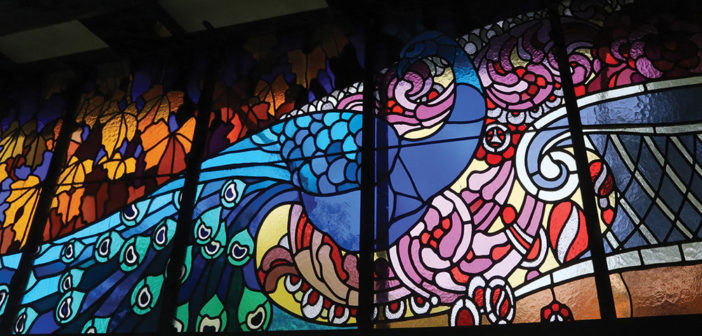![]()
Witraż z pawiami i… lakierki profesora
Sarnie Uroczysko 15 to zakątek w Krakowie, który warto odwiedzić! Stoi tu drewniana willa profesora Karola Estreichera jr., która stała się staraniem Towarzystwa Przyjaciół Sztuk Pięknych także Muzeum Rodu Estreicherów, Strat Kultury i Rewindykacji.
Wszak jej były właściciel Karol Antoni Estreicher jr. wybitny historyk sztuki, encyklopedysta, prozaik i profesor UJ był najwybitniejszym windykatorem zrabowanych przez Niemców w czasie drugiej wojny światowej polskich dzieł sztuki.
Profesor Karol Esteicher jr. był nie tylko wybitnym naukowcem i patriotą, ale człowiekiem pełnym fantazji i temperamentu. W młodości figlował i psocił, grał w piłkę szmaciankę na dziedzińcu wawelskim, wypuścił na Błoniach z bud rakarskich bezpańskie psy. Jako szacowny profesor i kierownik Muzeum UJ oprowadzając po Collegium Maius, potrafił żartować w obecności partyjnych dostojników. Nic dziwnego, że kiedy zakładał rodzinę wpadł na pomysł, aby… przenieść gotową drewnianą willę z Ojcowa na rodzinną działkę na Woli Justowskiej.
Willa zaprojektowana przez Józefa Gałęziowskiego jest domem w stylu profesorsko-mieszczańskim, na planie dworku polskiego z dwoma alkierzami. Do tego domu w 1948 roku sprowadził poślubioną po wojnie narzeczoną Teresę Lasocką, która w czasie wojny działała konspiracyjnie pod pseudonimem „Tell” w Pomocy Więźniom Obozów Koncentracyjnych. Razem stworzyli dom pełen wybitnych dzieł sztuki i niezwykłych pamiątek sentymentalnych. Prezes Kazimierz Witek podczas oprowadzania po willi z pieczołowitością wyciąga z szafy angielską bluzę mundurową z baretką, typu battle dress, w której profesor chodził po wojnie na wykłady w ASP w Krakowie. Zobaczyć można tekturowe pudełko z numerem 660, które „zagrało” w filmie „Katyń” Andrzeja Wajdy, będące prawdziwą urną z prochami prof. Stanisława Estreichera zamordowanego w niemieckim obozie koncentracyjnym Sachsenhausen – Oranienburg.
Pasja zbieracka profesora sprawiła, że w pudełeczkach i na półkach szafy odnaleźć można między innymi takie rarytasy jak łańcuszek do zegarka Ambrożego Grabowskiego, opaskę na rękaw Komitetu Obywatelskiego Straży Obywatelskiej Stanisława Estreichera, ząbki dzieci, śliniaczki, brzytwy i lornetki, srebra po kardynale Albinie Dunajewskim…
Szczególną estymą darzył profesor czarne lakierki kupione po wojnie w Wiedniu „za pieniądze, które przysłała Ewa (siostra profesora) z Londynu”. Buty te profesor dał Igorowi Trybowskiemu (b. prezesowi TPSP), a ten przekazał Maciejowi Miezianowi. Historia butów została solennie opisana odręcznie, na tekturowym pudełku…
Całość willi wieńczy na zewnątrz witraż Henryka Uziębły odnaleziony w piwnicach Pałacu TPSP z odrestaurowanymi szkłami wiedeńskimi. Są tam dwa pawie…
Ewa Kozakiewicz
![]()
A stained glass window with peacocks and … the professor’s patent leather shoes
Number 15 Sarnie Uroczysko St. is a nook in Krakow worth visiting! Here stands the wooden villa of Prof. Karol Estreicher, Jr., which, through the efforts of the Society of Friends of Fine Art (SFFA), became the Museum of the Estreicher Family, Lost Culture, and Recovered Artifacts.
In addition to being a notable art historian, encyclopedist, author, and professor at Jagiellonian University, no one did more than Karol Antoni Estreicher, Jr., the villa’s former owner, to recover works of art stolen by the Nazis in the course of the Second World War.
Prof. Estreicher was not just a notable academic and patriot, but he was also a person of great fantasy and temperament. In his youth he was a high spirited prankster. He played with a rag-ball on the Wawel courtyard, and liberated stray dogs from pound cages in Błonia park. As a respected professor and director of the Jagiellonian Museum, he managed to joke in the company of the communist party dignitaries whom he guided around the Collegium Maius. It was no wonder that when he began to raise a family, he came up with the idea of transporting an entire villa from Ojcow to his family’s land in Krakow’s Wola Justowska neighborhood.
The villa, designed by Joseph Gałęziowski, is a house in the professor-resident style, based on the plan of a Polish manor house with two alcoves. He brought his bride Teresa Lasocka whom he had married after the war to this house in 1948. During the war, Lasocka herself had worked with the Polish underground under the pseudonym of “Tell” trying to help the prisoners of the concentration camps. Together they established a home full of notable fine art, and unusual sentimental memorabilia. While showing people around the house, SFFA President Kazimierz Witek opens a closet and meticulously pulls out a shirt from an English uniform with a “battle dress” style ribbon, which the professor had worn to give lectures at the Academy of Fine Arts in Krakow. One could see the cardboard box with the number 660 that “played a role” in the film “Katyn” by Andrzej Wajda; the box being the very urn in which were held the ashes of Prof. Stanisław Estreicher who was murdered in the Nazi’s Sachsenhausen-Orangienburg concentration camp.
The professor’s passion for collecting meant that in boxes and on shelves one could find, among other things, such unique items as Ambroży Grabowski’s watch chain, Stanisław Estreicher’s Citizen’s Committee of the Civic Guard arm band, children’s milk teeth, bibs, razors and binoculars, and Cardinal Albin Dunajewski’s silver service…
The professor held in particularly high esteem a pair of black patent leather shoes bought in Vienna after the war “with money that Ewa (the professor’s sister) sent from London”. The professor gave these shoes to Igor Trybowski (former president of the SFFA), who subsequently engifted them to Maciej Miezian. The history of the shoes was duly recorded on the cardboard box…
The crowning work of the entire villa is the stained glass window by Henryk Uziębło made from restored Viennese glass which was found in the basement of the SFFA Palace. It depicts two peacocks…
Ewa Kozakiewicz









